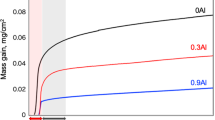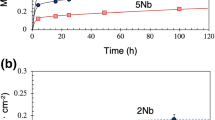Abstract
The halogen effect, which involves the surface enrichment of an alloy with a halogen element to result in improved oxidation resistance, was assessed using model Ni-based Ni–Cr–Al alloys. The alloys studied varied in composition in a manner that produced sub-critical, borderline and protective intrinsic oxidation behaviours from the standpoint of being able to form a continuous Al2O3 scale. Fluorine-ion implantation allowed for a well-defined surface do** of the alloys. It was found that this do** could promote protective Al2O3-scale formation during oxidation at 900 and 1,000 °C in both dry and steam-containing atmospheres. Specifically, the beneficial halogen effect was manifested by lowering the critical Al content in Ni–Cr–Al alloys needed for Al2O3-scale formation.


















Similar content being viewed by others
References
T. M. Pollock and S. Tin, Journal of Propulsion and Power 22, 361 (2006).
J. Litz, A. Rahmel, M. Schorr, and J. Weiss, Oxidation of Metals 32, 167 (1989).
H.-E. Zschau, D. Renusch, P. Masset, and M. Schütze, Materials at High Temperatures 26, 85 (2009).
H.-E. Zschau, D. Renusch, P. Masset, and M. Schütze, Nuclear Instruments and Methods in Physics Research B 267, 1662 (2009).
C. S. Giggins and F. S. Pettit, Journal of the Electrochemical Society 118, (11), 1782 (1971).
J. Ziegler, J. Biersack, and U. Littmark, The Stop** and Range of Ions in Solids, Version 95, (Pergamon Press, New York, 1995).
J. Biersack, Nuclear Instruments and Methods in Physics Research B 153, 398 (1999).
Landolt-Börnstein, Thermodynamic Properties of Inorganic Material, Scientific Group Thermodata Europe (SGTE), (Springer, Berlin-Heidelberg, 1999).
O. Knacke, O. Kubaschewski, and K. Hesselman, Thermochemical properties of inorganic substances, 2nd ed, (Springer, Berlin, 1991).
I. Barin, O. Knacke, and O. Kubaschewski, Thermochemical Properties of Inorganic Substances, Supplement, 861, (Springer, Berlin, 1977).
I. Barin, Thermochemical Data of Pure Substances, (VCH Verlags Gesellschaft, Weinheim, 1989).
H.-E. Zschau and M. Schütze, in Ion Implantation, ed. M. S. Goorsky, (InTech, Rijeka, 2012), p. 409. http://www.intechopen.com/books/ion-implantation.
J. W. Nesbitt and R. W. Heckel, Metallurgical Transactions A 18A, 2061 (1987).
Acknowledgments
The work was supported by the Deutsche Forschungsgemeinschaft (DFG) under contracts SCHU 729/24-1 and DO 604/17-1 which is gratefully acknowledged. The authors thank Dr. L. Schmidt and Dr. K. E. Stiebing from the Institute of Nuclear Physics of the Goethe-University Frankfurt for their support while using the implanter and the Van de Graaff-accelerator.
Author information
Authors and Affiliations
Corresponding author
Rights and permissions
About this article
Cite this article
Zschau, HE., Zhao, W., Neve, S. et al. Promotion of the Al2O3-Scale Formation on Ni–Cr–Al Alloys via the Fluorine Effect. Oxid Met 83, 335–349 (2015). https://doi.org/10.1007/s11085-014-9524-1
Received:
Revised:
Published:
Issue Date:
DOI: https://doi.org/10.1007/s11085-014-9524-1




